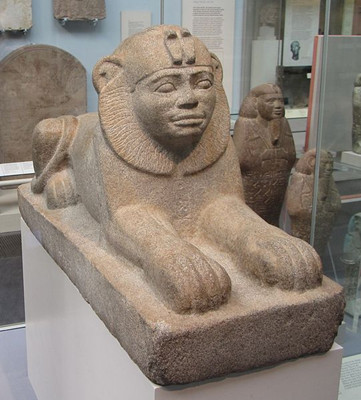Sphinxes-statues with a lion's body and a man's head-are creatures of myth and legend, but they're also one of the great symbols of Egyptian royalty and power.
狮身人面像,拥有狮子的身体,男性的头烦,来自古埃及神话传说,是埃及王权的重要象征。
The most famous of all, of course, being the Great Sphinx at Giza.
而位于吉萨的那一尊庞然大物,是其中最著名的一座。
Here it is now and, compared with the one at Giza, this sphinx is very small.
与吉萨的狮身人面像相比,本节提到的这一尊尺寸极小。
it's about the size of a spaniel-but it is particularly interesting, because it's not just a hybrid of a man and a lion, but a fusion of Egypt and Kush.
它的大小与一只西班牙猎犬相当,但它的特别之处在于,它并不只是狮子与人的混合体,也是埃及与库施王国结合的产物。
It's made out of sandy grey granite, and it's beautifully preserved.
它用灰色磨砂花岗岩制成,保存得极为完美。
The muscular lion's back, the mane of hair and the powerful outstretched paws are all classically Egyptian-but it's not a typical Egyptian pharaoh's face.
狮子健壮的背部、脖子上的鬃毛以及强健有力的前爪,都具有强烈的埃及雕像的特征。但它的脸带有明显的非洲黑人特征,不是典型的埃及法老的脸。
Because this man is unquestionably a black African, and this sphinx is the image of a black pharaoh.
这座狮身人面像刻画的是一位黑人法老。
Hieroglyphics on the sphinx's chest spell it out: this is a portrait of the great King Taharqo, the fourth pharaoh to rule over the combined kingdoms of Kush and Egypt.
雕像胸前的象形文字写着:这是伟大的塔哈尔卡王的雕像,他是库施与埃及联合王国的第四任法老。
For thousands of years, Egypt had looked on its southern Kushite neighbour essentially as a rich but troublesome colony,
数千年来,埃及一直把南方的库施看作一个富庶但棘手的属国。
that could be exploited for its raw materials-there was gold and ivory and, very important, slaves.
库施资源丰富,可提供黄金、象牙,以及最重要的奴隶。
In this almost colonial relationship, Egypt was very much the master.
在这种几乎殖民化的关系中,埃及是绝对的领主。
But in 728 BC, the balance of power flipped.
但在公元前七二八年,它们的力暈此消彼长。



